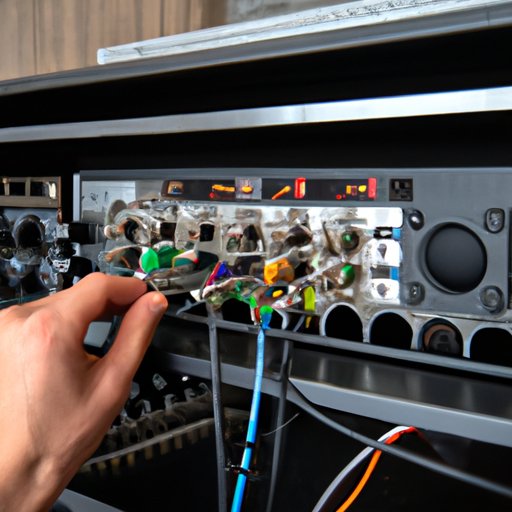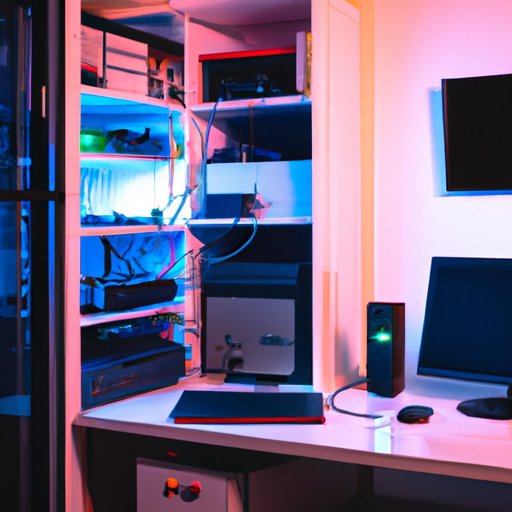Introduction
In today’s digital world, having a robust cybersecurity system is essential for protecting your data and other assets from malicious cyber attacks. For individuals who are interested in learning more about cybersecurity and developing their skills, building a home cybersecurity lab can provide an ideal environment for experimentation and exploration. In this article, we will discuss what equipment is needed to build a home cybersecurity lab, how to set up and configure the necessary equipment, and best practices for maintaining and securing the lab.
What Equipment is Needed for a Home Cybersecurity Lab?
Before getting started with building a home cybersecurity lab, it is important to understand the type of equipment that is needed for the lab. The most basic requirements include hardware such as computers, servers, and networking equipment, as well as security software to install in the lab.
Hardware Requirements
The hardware required for a home cybersecurity lab should be powerful enough to handle multiple virtual machines (VMs) running at the same time. According to an analysis conducted by TechRepublic, “For a good home lab, you’ll want to start with at least 16GB of RAM and a quad-core processor.” Additionally, having a separate storage device such as an external hard drive or USB flash drive is beneficial for backing up any files created in the lab.
Networking Equipment
Given that a home cybersecurity lab is essentially a small network, it is important to have the appropriate networking equipment to ensure everything works properly. This includes items such as routers, switches, and cables. Additionally, if the lab is going to be connected to the internet, then a modem is also required.
Security Software
Once the hardware and networking equipment are in place, the next step is to install various security software solutions in the lab. These solutions include firewalls, antivirus programs, intrusion detection systems, and endpoint protection solutions.

Setting Up and Configuring the Necessary Equipment
Once all of the necessary equipment has been acquired, the next step is to set up and configure the lab. This process involves connecting all of the hardware, installing the security software, and configuring the network settings.
Step-by-Step Process for Installation and Configuration
The first step in setting up and configuring a home cybersecurity lab is to connect all of the hardware components. This includes connecting the computers, servers, and networking equipment. Once the hardware is connected, the next step is to install the security software. Finally, the network settings need to be configured to ensure that everything is running correctly.
Tips for Successful Setup
When setting up and configuring a home cybersecurity lab, it is important to pay attention to detail and follow the instructions carefully. Additionally, it is recommended to keep a record of all the settings and configurations so that they can be easily referenced in the future. Lastly, it is helpful to have an experienced cybersecurity professional on hand to answer any questions that may arise during the setup process.

Different Types of Security Software to Install in the Lab
Once the hardware and networking equipment have been set up and configured, the next step is to install various security software solutions in the lab. These solutions are designed to protect the lab from malicious cyber attacks and other threats.
Firewall Software
Firewall software is essential for any home cybersecurity lab. It helps to protect the lab from unauthorized access and other malicious activities by monitoring incoming and outgoing traffic. Additionally, firewall software can be used to block certain types of traffic and control user access.
Antivirus Software
Another important security solution to install in the lab is antivirus software. This software helps to detect and remove malware and other malicious programs that may be present on the system. Additionally, it can be used to scan files and emails for potential threats.
Intrusion Detection Systems
An intrusion detection system (IDS) is another important security solution for a home cybersecurity lab. This software is designed to detect suspicious activities on the network and alert administrators when potential threats are identified. Additionally, IDS can be used to analyze network traffic for anomalies and take action to mitigate the threat.
Endpoint Protection Solutions
Finally, it is important to install endpoint protection solutions in the lab. These solutions help to protect devices from malicious software, as well as monitor user activity on the network. Additionally, they can be used to enforce access control policies and detect suspicious behavior.

Keeping Your Home Cybersecurity Lab Secure
Once the lab is up and running, it is important to maintain and update the security software regularly to ensure that the lab remains secure. Additionally, there are several strategies that can be employed to detect and respond to potential threats.
Best Practices for Maintenance and Updating
To ensure the security of a home cybersecurity lab, it is important to keep the security software up-to-date. This includes regularly patching and updating the software, as well as running scans to detect any potential vulnerabilities. Additionally, it is important to monitor the network for suspicious activity and take immediate action if any issues are identified.
Strategies for Detecting and Responding to Threats
In addition to regular maintenance and updates, it is also important to have a strategy in place for detecting and responding to potential threats. This includes having a plan for identifying, isolating, and responding to malicious activities. Additionally, it is important to have procedures in place for reporting incidents and taking steps to mitigate the damage caused by the attack.
Troubleshooting and Testing Security Solutions in the Lab
In addition to maintaining and securing the lab, it is also important to be able to troubleshoot and test security solutions in the lab. This allows administrators to identify and resolve any issues that arise, as well as evaluate the effectiveness of the security solutions.
Tips for Troubleshooting Issues
When troubleshooting issues in a home cybersecurity lab, it is important to approach the problem systematically. This includes gathering information about the issue, running diagnostic tests, and researching possible solutions. Additionally, it is helpful to have an experienced cybersecurity professional on hand to provide assistance if needed.
Techniques for Testing Solutions
Testing security solutions in a home cybersecurity lab is an important part of ensuring the effectiveness of the solutions. This includes using penetration testing techniques to identify and exploit vulnerabilities, as well as evaluating the performance of the security solutions under various scenarios. Additionally, it is important to use real-world data to test the solutions and ensure that they are able to detect and respond to threats effectively.
Conclusion
In conclusion, building a home cybersecurity lab provides an ideal environment for learning about cybersecurity and developing the necessary skills. This article discussed the essential equipment needed for the lab, how to set up and configure the necessary equipment, different types of security software to install, strategies for keeping the lab secure, and tips for troubleshooting and testing solutions. By following these tips and strategies, individuals can create a secure and functional home cybersecurity lab.
(Note: Is this article not meeting your expectations? Do you have knowledge or insights to share? Unlock new opportunities and expand your reach by joining our authors team. Click Registration to join us and share your expertise with our readers.)
